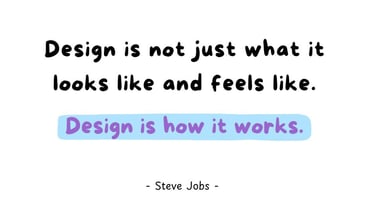Why Our Brain Loves Beautiful Products? Neuroaesthetics and UX
While neuroaesthetics initially focused on understanding how humans perceive and experience visual art, it quickly expanded to include music, architecture, and other art forms. As technology advances and websites and applications have become integral parts of our daily lives, utilizing neuroaesthetics research to understand how we perceive digital design becomes greatly helpful to UX professionals too.
The term was coined in 1999 by the neurobiologist Semir Zeki in his book Inner Vision: An Exploration of Art and the Brain and received its formal definition in 2002. Zeki was among the first who scientifically explored how the brain reacts to art and beauty. By studying the brain’s response to visual art, he discovered that specific patterns, shapes, and colors trigger pleasure and reward centers in the brain.
References:
Beauty, Stanford Encyclopedia of Philosophy
Marcos Nadal, Marcus T. Pearce (2011) The Copenhagen Neuroaesthetics Conference: Prospects and pitfalls for an emerging field, Brain and Cognition, 76 (1), pp 172-183
Rüdiger F. Pohl (2016). Cognitive Illusions: Intriguing Phenomena in Judgement, Thinking and Memory
Susan Magsamen (2019), Your Brain on Art: The Case for Neuroaesthetics, Cerebrum
Berlyne, D. E (1971) Aesthetics and psychobiology
Tomohiro Ishizu, Semir Zeki (2011) Toward A Brain-Based Theory of Beauty, PLOS ONE 6(7)
Masaaki Kurosu, Kaori Kashimura (1995) Apparent usability vs. inherent usability: experimental analysis on the determinants of the apparent usability,
Thomas Jacobsen, Lea Höfel (2003) Descriptive and evaluative judgment processes: Behavioral and electrophysiological indices of processing symmetry and aesthetics, Cognitive, Affective & Behavioral Neuroscience, 3(4), 289–299
Fangfu Lin, Wanni Xu, Yan Li, Wu Song (2024) Exploring the Influence of Object, Subject, and Context on Aesthetic Evaluation through Computational Aesthetics and Neuroaesthetics, Applied Sciences, 14(16)
Gitte Lindgaard, Gary Fernandes, Cathy Dudek (2006), Attention web designers: You have 50 milliseconds to make a good first impression! Behaviour and Information Technology, 25(2)
Imagine walking through an art gallery, pausing in front of a painting that inexplicably draws you in. You can’t quite explain why, but the colors, the balance of shapes, and the composition evoke a feeling of calm and joy.
Now, picture scrolling through a beautifully designed app. The clean lines, the intuitive layout, and the harmonious color palette draw you in, making you feel at ease, and, strangely enough, you trust the brand more because of it.
Finally, all these laid the groundwork for the formal development of neuroaesthetics at the beginning of the 21st century. Bridging the fields of neuroscience, psychology, and aesthetics, neuroaesthetics provides insights into how our brains process artistic experiences and how these affect our emotions, cognition, and behavior.
The fascination with aesthetics and beauty comes from the ancient times. Greek philosophers, such as Plato and Aristotle, were among the first to examine the concept of beauty as an objective truth. Plato thought that beauty is not bound to the sensible object but it exists autonomously. However, Aristotle thought beauty is rooted in proportion, harmony, and symmetry.
Since then, for centuries, philosophers and artists have wondered what causes certain works of art to resonate deeply with us, and how art and beauty can evoke emotions or spark our imagination.


📷 by Marishka Tsiklauri from Unsplash
As in this famous saying of Steve Jobs, I strongly believe that design is fundamentally about problem-solving. However, throughout my career as a UX researcher, observing both my own and hundreds of others’ experiences has shown me that visually appealing designs consistently outperform those with poor aesthetics.
So, what might be the reasons behind this?


What makes these experiences so captivating?
What happens in our brain that links art and pleasure, beauty and trust?
The Past and Present of Studying Aesthetics
In the middle of the 19th century, Darwin studied the perception of beauty in humans, focusing on evolutionary factors. In the late 19th century, as psychology started developing as a scientific discipline, researchers began to explore how humans perceive beauty and aesthetics using empirical methods.
In the 1870s, Gustav Fechner, a German physicist, philosopher, and experimental psychologist, conducted experiments to explore why people find certain forms, shapes, or patterns more aesthetically pleasing than others. By applying empirical methods, he founded a new sub-field of psychology known as experimental aesthetics. His research focused on how visual forms, such as symmetrical patterns or harmonious proportions, impact visual perception and why they are perceived as beautiful.
Neuroaesthetics and UX
The mid-20th century witnessed rapid developments in psychology and neuroscience, leading to a more profound comprehension of perception, cognition, and emotion. During this period, the brain was increasingly acknowledged as the central organ responsible for processing aesthetic experiences.
However, it wasn't until the late 20th century that scientists could begin to study the brain's responses to aesthetics in detail, thanks to advancements in brain imaging technologies like EEG (electroencephalogram) and fMRI (functional magnetic resonance imaging). As neuroscience evolved, so did interest in the neural underpinnings of aesthetic experiences. Researchers began examining how various brain regions react to stimuli such as paintings, music, and even architecture.
Today neuroaesthetics continues to expand, incorporating more interdisciplinary research from fields like cognitive neuroscience, evolutionary psychology, art history, and even artificial intelligence. Scientists even study how aesthetics might affect our mental health and overall well-being.
Another reason why we prefer beautiful, aesthetically pleasing stimuli might be associating it with reward or pleasure. Researchers Tomohiro Ishizu and Semir Zeki discovered that beautiful paintings and musical excerpts stimulate brain regions, associated with pleasure and reward. Studies also showed that a similar area of the brain is activated when we perceive something beautiful regardless of the stimulus' nature.
If we translate these findings into UX, we can say that designing visually pleasing interfaces can enhance user satisfaction, engagement, and even loyalty toward a particular product and brand.
The Aesthetic Experience and Brain's Reward System
Visual Appeal Determines Users' Attitudes
In psychology, it's a well-known fact (Halo effect) that positive impressions of a subject or object in one area lead us to have positive feelings in another area. Research has consistently demonstrated that a person's perceived attractiveness influences judgments about them - attractiveness is often linked with positive characteristics and high moral qualities.
Similarly, research in neuromarketing and consumer neuroscience, also increasingly observes that beautifully designed product packaging or advertisement can lead consumers to form an overall positive impression, and make them believe the product is of higher quality. This effect can also impact brand perception - when a company consistently produces visually appealing products, consumers are more likely to trust the brand and perceive its products as reliable.
Recent studies by Lindgaard, Fernandes, and Dudek showed that the visual appeal of the websites influenced the overall perception and likeness of the website among users. What is more interesting is that, according to this research, It takes as little as 50 milliseconds for users to form an opinion about a website and decide whether they like it or not.
Aesthetic–Usability Effect
The aesthetic-usability effect suggests that people perceive aesthetically pleasing designs as much more intuitive and usable than those evaluated as less aesthetically pleasing.
This concept was first formally studied in 1995 by researchers Masaaki Kurosu and Kaori Kashimura at Hitachi Design Center in Japan. In their experiment, Kurosu and Kashimura tested the usability of 26 automated teller machine (ATM) interfaces. They asked participants to evaluate the usability of the interfaces. The catch was that some of the designs were intentionally made more aesthetically appealing than others, without any functional difference. The results were impressive: participants consistently rated the aesthetically pleasing interfaces as more usable, even when their actual usability was the same as the less attractive designs.
This initial study provided strong evidence that users' perceptions of usability are influenced by a product's visual appeal. This insight has since been confirmed by numerous other studies.


Google's search page demonstrates the power of simplicity, making it visually appealing and easy to use.
Final Words
To sum up, the significance of aesthetics and beauty in UX design cannot be overstated. Insights from psychology, neuroaesthetics, neuromarketing, and other relevant fields demonstrate that the brain’s response to visual beauty significantly affects human perception, emotional engagement, and decision-making.
In UX design, creating visually appealing interfaces can not only enhance usability but also evoke positive emotional responses, leading to stronger brand loyalty and improved user satisfaction.
As technology continues to evolve, the increased incorporation of psychology and neuroscience with HCI and User Experience will play a key role in shaping the future of product design.
Simplicity Is Associated With Aesthetic Pleasure
Studies also show the connection between an object's simplicity and aesthetical appealing. Berlyne’s Arousal Theory of Aesthetics suggests that people are naturally drawn to patterns that are neither overly complex nor too simplistic.
The brain prefers simplicity due to its inherent desire to conserve energy. When faced with overly complex stimuli, the brain must work harder, leading to frustration and reduced engagement.
Thus, simplicity, if used properly, plays a key role in enhancing user satisfaction by minimizing cognitive load.
Moroever, studies utilizing fMRI and EEG have revealed how our brains respond to colors, symmetry, balance, and visual harmony, which I will discuss in future posts.


